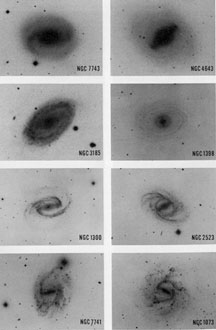


5.5 Pure Barred Galaxies
Pure cases of the r and s varieties are shown in Plate 6, s on the left, r on the right. As previously mentioned, NGC 3185 (Atlas, p. 43; and Plate 6 here) is especially interesting because of the very tightly wound arms, which on casual inspection appear (incorrectly) to form a complete ring. The first galaxy in the upper left [NGC 7743; SBa(s) Hubble, or (R?)SB(s)0+ de Vaucouleurs, which must be a misclassification because of the presence of distinct arms] has a similar pattern, but the arms are more clearly separated, perhaps due to a more favorable orientation of this galaxy to the line of sight. The separation of the end of the bar and the arm that begins at the opposite end of the bar increases progressively along the classification sequence, being clearly separated at the SB (s)b stage, such as NGC 1300 (Atlas, p. 45; and Plate 6). This separation can be used as a secondary classification criterion for SBa and SBb types (cf. the discussion on p. 23 of the Hubble Atlas text).

|
Plate 6. Barred spirals, showing the division into r and s types. Galaxies where the arms start from the end of the bar (s types) are shown on the left. Galaxies in which they begin tangent to an internal ring (r) are on the right. Within each column, the galaxies are arranged in the order from early to late. The one mixed type that is illustrated is NGC 1073 [SBc(rs)] at the lower right. NGC 3185 in the left column is of (s) variety, although it may appear to have a complete ring on small-scale plates. The arms do not touch to form a ring, but are very tightly wound after starting from the end of a bar. |
As with the ordinary spirals, the resolution into stars increases, and the arms become more prominent relative to the amorphous central regions (the spheroidal component) as one progresses from the a to d subclasses. These monotonic changes are particularly evident in Plate 6.